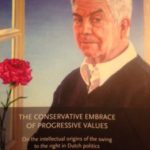Reshaping Remembrance ~ The Woordeboek van die Afrikaanse Taal
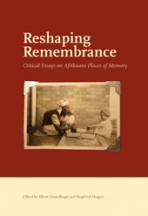 1.
1.
For the average language user, a dictionary is something that you do not argue with, that you rely on with varying levels of success to regain lost knowledge, for help with crossword puzzles and that you sometimes, very successfully, use to press flowers or as a doorstop. But despite the nature of the use of a dictionary – whether it is in fulfilling its genuine purpose or not – the typical user sees the dictionary as an authoritative container of grammatical and other information that provides the holy truth. That’s why in spoken language people do not refer to ‘a dictionary’ but to ‘the dictionary’ – almost like The Bible. Not everybody is aware of the existence of a variety of dictionary types, each having to comply with its own typological criteria and help a specific target user group in a particular way to meet their specific needs in accordance with their research skills. One particular dictionary can’t be everything for everybody – that is something that dictionary users often have to be reminded of. The fact that each specific dictionary has a distinct role in the recording and reproduction of language is also seldom emphasised. Moreover, the fact that between the wealth of dictionaries there is one which can be seen as the crown jewel of the dictionary family is also not always recognised. This jewel is the comprehensive explanatory dictionary, and in Afrikaans this typological place is occupied by the Woordeboek van die Afrikaanse Taal (Dictionary of the Afrikaans Language), commonly known as the WAT.
The WAT as comprehensive dictionary is a source of information – as supplement, as affirmation and often also as reminder. But as Afrikaans source of reminding it is not only the content of the Woordeboek van die Afrikaanse Taal that is relevant, but the history of this dictionary as well that calls one’s attention to numerous places of remembrance. As far as the content of the WAT is concerned, one must take note of the fact that a comprehensive dictionary typically consists of multiple volumes compiled over decades – for example, it took 148 years to complete the comprehensive Het Woordenboek der Nederlandsche Taal (The Dictionary of the Dutch Language). The comprehensiveness of such a dictionary lies in its choice of items included for treatment, in the variety of data types that are treated in the dictionary as well as the nature and the extent of their treatment. The comprehensiveness with regard to the choice of words brings about the fact that such a dictionary includes a lot of words and phrases for treatment and in that way makes the user aware of various old and lesserknown language forms. The dictionary becomes a recollection of bygone and less ordinary language use; this is what the WAT is par excellence. In his reaction to a very negative discussion of his Webster’s Third New International Dictionary of 1961 in Life magazine, a discussion which, like many others, condemned this dictionary for not being prescriptive enough, the American lexicographer Philip Gove said the following:
The responsibility of a dictionary is to record language, not set its style. For us to attempt to prescribe language would be like Life reporting the news as its editors would prefer it to happen.
Read more
Pioneering Women War Correspondents
“Pioneering Women War Correspondents” profiles six trailblazing women journalists, including Peggy Hull, Martha Gellhorn, Marguerite Higgins and Dickey Chapelle, who reported from the front lines. Author Penny Colman narrates. Produced by Milena Jovanovitch
Martha Gellhorn ~ A Furious Footnote In History
In a man’s world she was one of the few women. Whereas her fellow journalists reported the war as if keeping score, she concentrated on the reality behind the statistics. She reported the Spanish Civil War, the Second World War, Vietnam and Panama. What is it that drives her to these hotbeds ? An interview (conducted in 1991) with an angry old lady.
In 1983, and far into her seventies, Martha Gellhorn can contain her anger no longer. This time the destinations are Nicaragua and El Salvador. She still shudder at the memory.
‘In Central-America was the first time I’ve ever felt real fear. You couldn’t see or hear the danger approaching. Suddenly it was there.’ Back at home England’s Granta publishes a report of hers on an instance of torture. Described in minute detail from the victim’s own account, smuggled out to her under the greatest secrecy – via the Red Cross – by a representative of a human rights organization in San Salvador.
‘There are murders committed every day in El Salvador and it’s costing the American taxpayer enormous sums of money, for no reason. We support these murderers. This has to be stopped.’
Her war coverage, collected in the book The Face of War, and her own choice of her peacetime writings The View from the Ground, are the distillations of sixty years of anger and indignation at the state of affairs in the world in general and in her native United States in particular.
‘The reason I’ve been able to travel all over the world and talk to anybody I want, is that I appear to be harmless, unimportant. I don’t make notes, it’s just like talking to a stranger in the street. If you have a photographer with you or take notes, people notice straight away. They become aware of the situation and tense up, they become cautious, less natural. And, in any case, I wasn’t important enough to have a photographer along.’
In the television film Hemingway Martha Gellhorn is presented as a fanatical, blonde and ambitious journalist. Fanatical she has never been, blonde she has and if it’s ambitious to want to be heard, than she is ambitious. Before she met Hemingway, on holiday in Florida, she had already written a book about unemployment in America in the thirties, entitled The Trouble I’ve Seen. Later she published short stories, ten novels and account of the travels: Travels with Myself and Another.
She married Hemingway in 1940, but the marriage wasn’t to survive the Second World War.
‘I was married to that terrible man for four of five years and am punished daily for that. I don’t want to see his name in your article’, she decrees with a determined look in her eyes. At eighty-one Gellhorn still shows traces of being the beauty to whom Hemingway dedicated For Whom the Bell Tolls.
In the Spring of last year (1990) Bill Buford, Editor-in-Chief of Granta receives a telephone call from Martha Gellhorn. This time it’s Panama. Her report is rife with distrust of the official American version of events. Distrust also of the American and Panamanian authorities. Five thousand words, one for each of the estimated number of dead. The number of injured is unknown. ‘They remain unseen. The Panamanian authorities have admitted that in one night fifteen thousand families were made homeless.’ Read more
Colonial Film Database ~ Moving Images of the British Empire
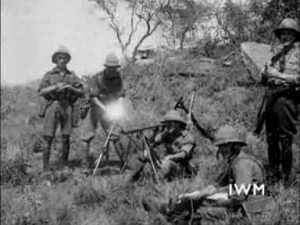 Welcome to Colonial Film: Moving Images of the British Empire. This website holds detailed information on over 6000 films showing images of life in the British colonies. Over 150 films are available for viewing online. You can search or browse for films by country, date, topic, or keyword. Over 350 of the most important films in the catalogue are presented with extensive critical notes written by our academic research team.
Welcome to Colonial Film: Moving Images of the British Empire. This website holds detailed information on over 6000 films showing images of life in the British colonies. Over 150 films are available for viewing online. You can search or browse for films by country, date, topic, or keyword. Over 350 of the most important films in the catalogue are presented with extensive critical notes written by our academic research team.
The Colonial Film project united universities (Birkbeck and University College London) and archives (British Film Institute, Imperial War Museum and the British Empire and Commonwealth Museum) to create a new catalogue of films relating to the British Empire. The ambition of this website is to allow both colonizers and colonized to understand better the truths of Empire.
Take a look: http://www.colonialfilm.org.uk/home
The Nigerian-Biafran War
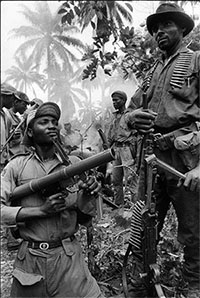 May 30 2017 marks the 50th birthday of the declaration of independence of the republic of Biafra, leading up to a 30-month civil war between federal Nigerian troops and the (Igbo) secessionists. On the occasion of this anniversary, the Library, Documentation and Information Department at the African Studies Centre in Leiden (ASCL) has compiled a web dossier on the Nigerian Civil War (1967–1970), also known as the Biafran War.
May 30 2017 marks the 50th birthday of the declaration of independence of the republic of Biafra, leading up to a 30-month civil war between federal Nigerian troops and the (Igbo) secessionists. On the occasion of this anniversary, the Library, Documentation and Information Department at the African Studies Centre in Leiden (ASCL) has compiled a web dossier on the Nigerian Civil War (1967–1970), also known as the Biafran War.
Far from being an exhaustive or even representative overview of the record of scholarship that has appeared on this topic, this dossier is an attempt to highlight different discourses reflected in the ASCL Library’s collection. After the introduction, section 2 presents a selection of publications on the war, ranging from a 1967 propaganda leaflet by the Nigerian government of information (Unity in Diversity) to a 2016 article on ‘the tensions in Nigeria-Biafra war discourses’. A highlight of this section is a collection of student essays on the civil war written in 1971 at the Toro teacher’s college. The cahiers were donated by their teacher, Aart Rietveld. Noteworthy is also the civil war chapters in the textbook series on civics and history for primary schools.
The third section deals with fictional accounts, personal narratives and poetry on the Biafran conflict, illustrating how much more literature there is than the (rightly famous) writings of Ken Saro-Wiwa, Adichie and Achebe.
Sections 4,5 and 6 capture the conflict through the biographical lenses of key actors. Writings by and about the two political protagonists, General Gowon (Nigerian head of state 1966–1975) and General Ojukwu (president of Biafra 1967–1971), give an insight into the federal and Igbo perspectives of the conflict. The third person chosen for this biographical section is the Yoruba nationalist Obafemi Awolowo, who was active as Federal Commissioner for Finance in Gowon’s cabinet during the war. Chinua Achebe portrays Awolowo as the architect of the starvation policy meant to crush the Igbo defence: “It is my impression that Chief Obafemi Awolowo was driven by an overriding ambition for power, for himself in particular and for the advancement of his Yoruba people in general. […] In the Biafran case it meant hatching up a diabolical policy to reduce the numbers of his enemies significantly through starvation […].”(There was a country, p. 233). This view contrasts strongly with the almost hagiographic accounts of “the man of courage , wisdom, reason and vision” (according to Moses Makinde).
The dossier is concluded with a selection of web resources and is introduced by former LeidenASA fellow Jays Julius-Adeoye, who recently published ‘The Nigeria-Biafra war, popular culture and agitation for sovereignty of Biafra nation’ in the ASCL working paper series.
The Vrije Universiteit And South Africa, From 1880 To The Present And Towards The Future: Images, Practice And Policies ~ Contents
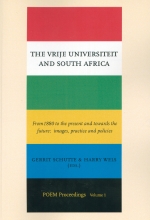 SAVUSA POEM Proceedings, Volume 1 – Rozenberg Publishers 2005 – ISBN 90 5170 587 5 – Soon complete online
SAVUSA POEM Proceedings, Volume 1 – Rozenberg Publishers 2005 – ISBN 90 5170 587 5 – Soon complete online
Contents
Part I: – The history of the relationship between the Vrije Universiteit and South Africa
* Introduction – Gerrit Schutte & Harry Wels
* The Vrije Universiteit & South Africa: 125 years of sentiments and good faith – Gerrit Schutte
* The Vrije Universiteit and South Africa since 1972: Political and organisational developments – Harry Brinkman
* Can ‘new’ meet ‘old’? VU-South Africa, 1976-present: Development cooperation in Southern Africa – Kees van Dongen & Leo de Feiter
Part II: A ‘new’ science for a ‘new’ South Africa: four current academic projects
* A ‘new’ history for a ‘new’ South Africa – Gerrit Schutte
* ANNA and a ‘new’ lexicography for South Africa – Willy Martin
* A ‘new’ literature – Ena Jansen
* A new size of theology for a new South Africa – Bram van de Beek
Part III: A ‘new’ science for a ‘new’ South Africa: Reflections
* South Africa-VU: The meaning of traditions for future VU-policy in South Africa? – Carools Reineke
* Some trends in South African academic history: Changing contexts and challenges – Albert Grundlingh
* Political studies in South Africa. A personal perspective – Tom Lodge
* Stimulating research futures – Tessa Marcus
* International R&D cooperation with South Africa – Selected policy perspectives – Hendrik C. Marais’
* ‘New’ scientific practice in South Africa with special reference to land reform – Flip Smit
* The changing Higher Education landscape in South Africa – Daniel Ncayiyana
* Good neighbours and far friends; The Netherlands, Europe and South Africa – Peter Nijkamp



